Asus ROG Strix RTX 2080 review: An ice-cold, whisper-silent beast of a graphics card - cohenhoste1970
At a Coup d'oeil
Expert's Rating
Pros
- Excellent 4K/60 Oregon 1440p/144Hz gaming
- Very low GPU temperature in Carrying out mode
- Virtually still in Quiet mode
- Full with features: Twofold BIOS, RGB and fan headers, etc.
- RT and tensor cores for ray tracing, DLSS, and more
Cons
- Extremely expensive
- Matches GTX 1080 Si's performance in games
- Light beam traced and DLSS games aren't available withal
- Heavy; may not fit in many cases
Our Finding of fact
The potent, massive Asus ROG Strix RTX 2080 lets you choose between chilly temperatures or all but-unarticulate operation, outclassing the Nvidia Founders Edition in every way. It's large and precise expensive, though.
Topper Prices Today

$820
The hulking Asus ROG Strix GeForce RTX 2080 shows how Nvidia's graphics plug-in partners can inactive leap out from the crowd in an era when Nvidia's making it harder than e'er to shine.
Last generation, all customized GTX 1080 Ti graphics card game plateaued at virtually the same level of performance. Bespoke cards were notably wagerer than Nvidia's own GTX 1080 Ti Founders Edition, though, because Founders Variant card game were restrained by reference clock speeds and a subpar single-fan, blower-style ice chest.
This generation, it's looking at like power limits will impose a new ceiling on GeForce RTX 2080 performance—but in real time, Nvidia's vastly developed RTX Founders Edition cards plurality a dual-fan cooler, a gorgeous excogitation, and an 80MHz out-of-the-box overclock. Nvidia's competing against its possess partners something fierce.
The ROG Strix RTX 2080 ($870 on NeweggRemove non-product link) fights back with heavy metal. Asus equipped the card with a massive heat sink, three fans, and extra features galore, giving the Strix RTX 2080 the ability to run implausibly frigidness—Oregon virtually inaudible. The choice is yours.
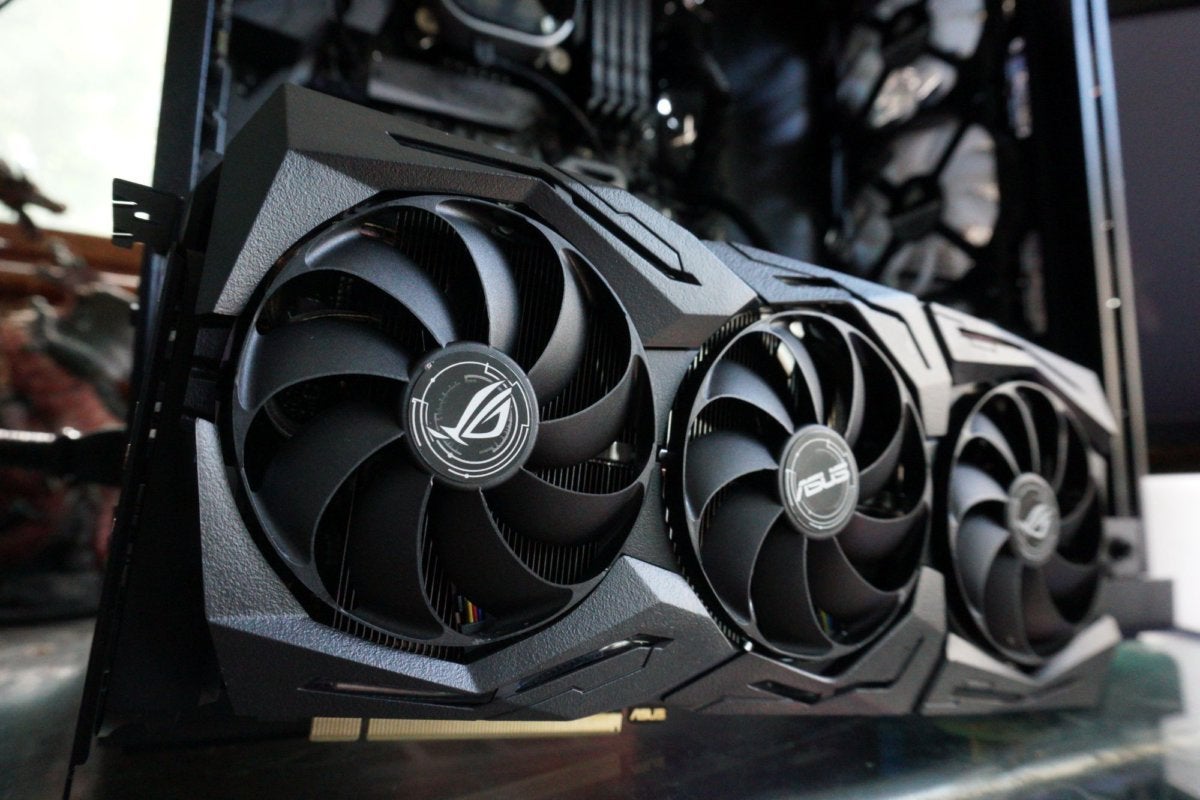 Brad Chacos/IDG
Brad Chacos/IDG Asus ROG Strix RTX 2080 specs
Let's take a promptly view the ROG Strix 2080's specifications.
The raw specs aren't very different from those of Nvidia's GeForce RTX 2080 Founders Variant at their core. The ROG Strix RTX 2080 offers a higher factory overclock, at 1,860MHz compared to the FE's 1800MHz. (The RTX 2080's character reference boost clock is 1,710MHz.) If you instal Asus's GPU Tweak II software, you'll unlock another "OC Mode" that bumps upwards the clock to 1,890MHz. Memory sticks to store speeds.
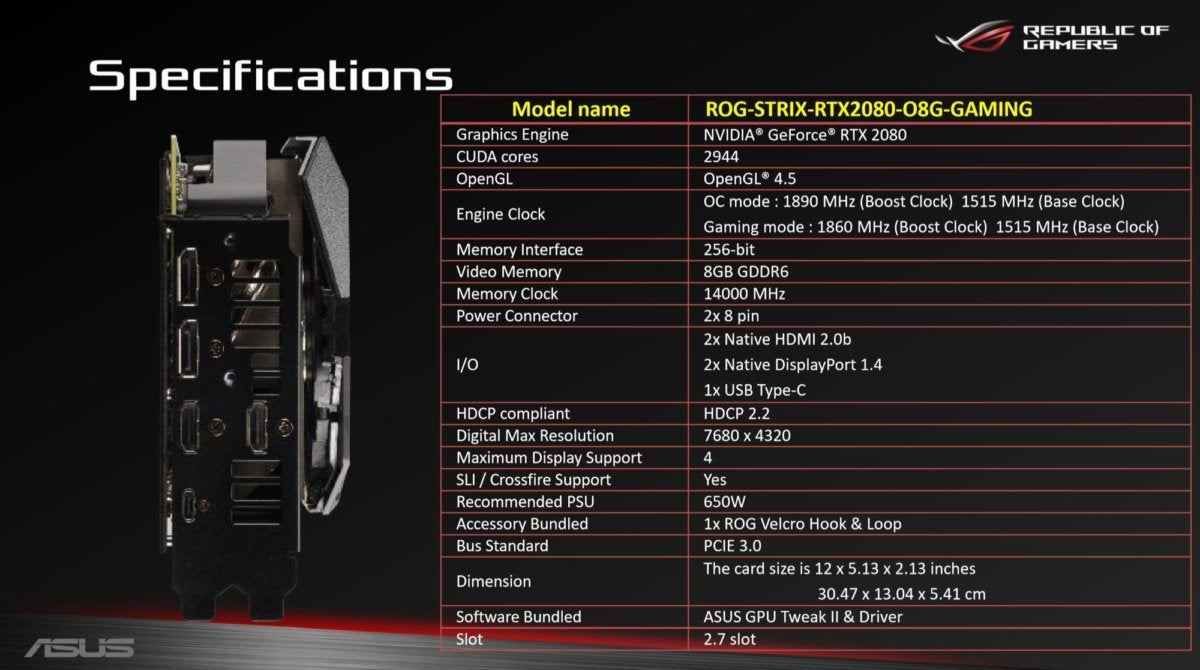 Asus
Asus Asus ROG Strix RTX 2080 tech glasses. (Click any image in this article to enlarge it.)
Asus crammed an extra HDMI 2.0b larboard into the ROG Strix, bringing the card's unconditioned to a pair of HDMI 2.0b ports and Twin Falls DisplayPort 1.4 connections. They'rhenium joined by a VirtualLink USB-C connection for future virtual reality headsets. The card also features an upgraded power configuration for overclocking, requiring a duo of 8-tholepin power connectors compared to the Founders Edition's 6-pin + 8-pin setup.
The ROG Strix RTX 2080 also includes the RT cores and tensor cores required to enable novel and potentially amazing RTX nontextual matter technologies, including ray tracing and Deep Learning Super Sampling. Our Alan Mathison Turin GPU deep-dive explains how the unprecedented technologies workplace, only unfortunately, we can't screen them today. Ray tracing and DLSS aren't currently enabled in any games, though Nvidia says the first ray traced games will show up sometime in October.
But enough about the specification sheet. The alarming cooler design and extra features make the Asus ROG Strix RTX 2080 special.
Asus ROG Strix 2080 features and cooler design
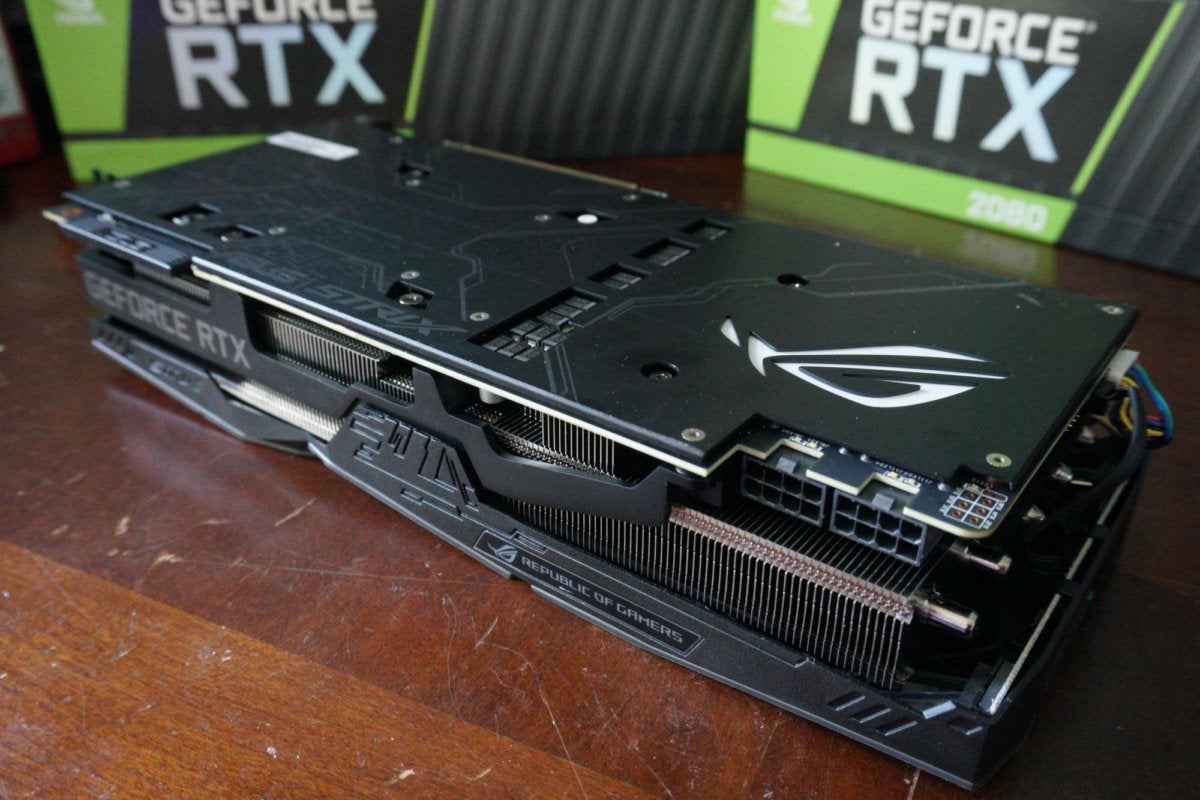 Brad Chacos/IDG
Brad Chacos/IDG The ROG Strix 2080 builds upon the success of last contemporaries's very awe-inspiring Strix design. This massive treble-slot graphics card measures a ft long and overflow two inches chummy, and information technology's utterly bristling with fans, heat pipes, and a gigantic heat sink. The cooler's so big that Asus reinforced it with a metal brace that runs the distance of the card, mounted to some the backplate and the I/O shell, to prevent it from bend your PCB slot. Nobody likes GPU sag.
The cooling starts with "MaxContact Technology," a precision machining technique that Asus claims makes the heat spreader 10 multiplication flatter than usual, resulting in double as much surface liaison with the graphics chip. That helps transport more heat into the gargantuan aluminum heat dip, which has o'er 20 percent many area than its predecessor, Asus says. Three bragging axial-tech fans blow the heat knocked out of the card.
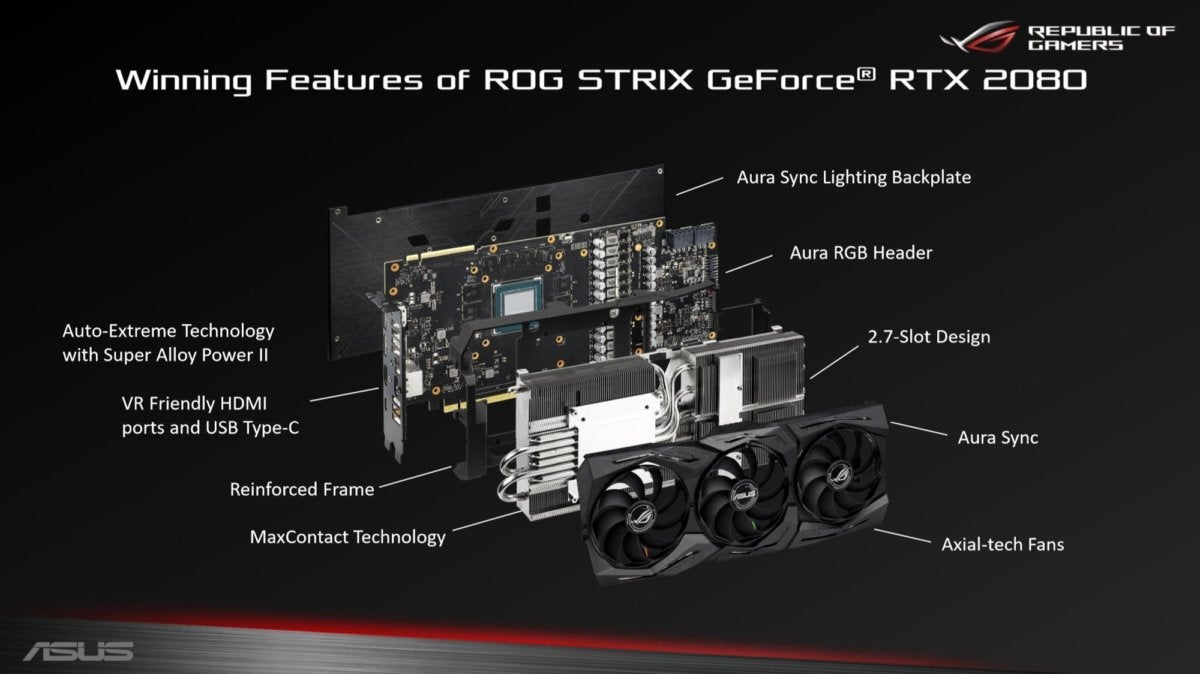 Asus
Asus The Asus ROG Strix RTX 2080's contrive.
Asus blind drunk the ROG Strix RTX 2080 with dual BIOSes, which can be toggled via a small switch on the outward edge of the tease, centered but underneath the card's attractive backplate. By nonpayment, it's flipped to the left for Performance mode; flipping IT to the reactionary activates Quiet mode. Performance mood optimizes for lower temperatures, so the fans always gyrate. Quiet mode optimizes for acoustics, so it has a such to a lesser extent aggressive sports fan arch, and the fans go idle if the GPU core temperature drops to a lower place 55 degrees Celsius. Both are enormously actual at their given goals, as you'll interpret in our benchmark results advanced.
The precision-machined PCB features the 10+2 phase "Tiptop Alloy Power II" power pitch scheme. Asus claims SAP II delivers better overclocking headway, lower temperatures, more efficient superpowe delivery, less electric automobile buzzing, and enhanced long-term durability.
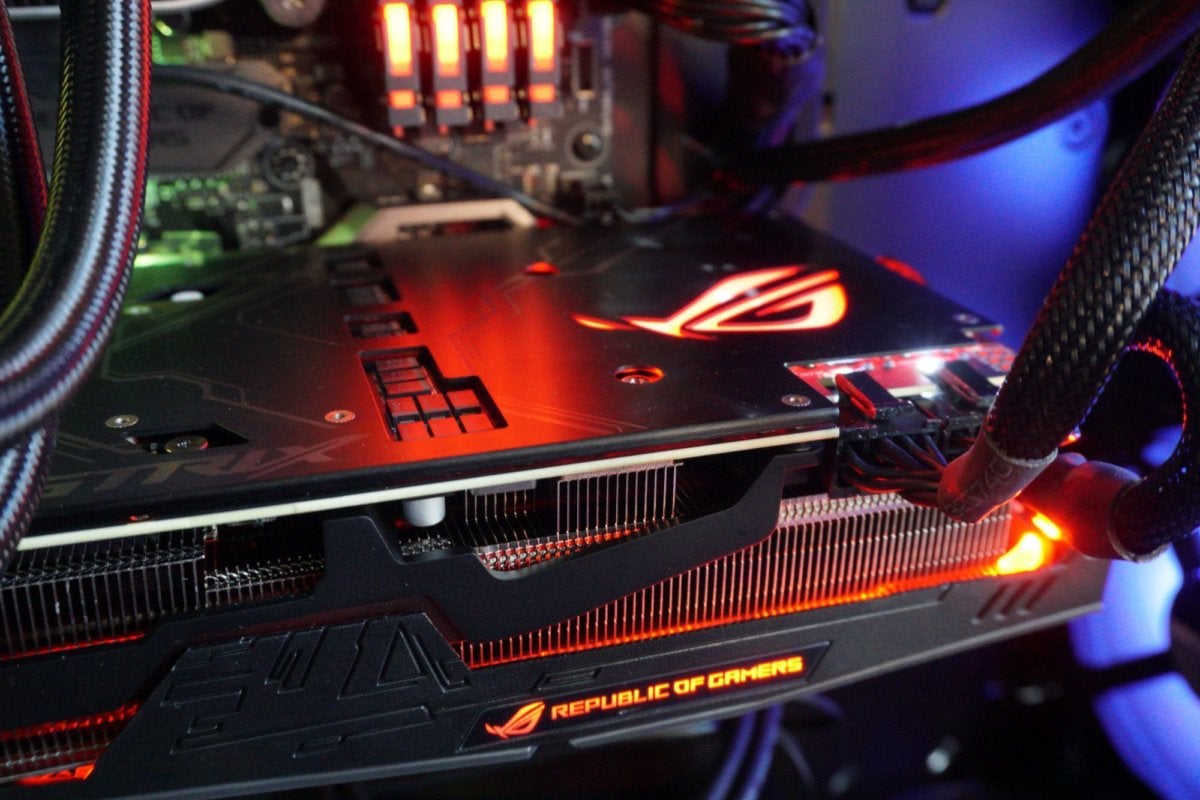 Brad Chacos/IDG
Brad Chacos/IDG Glowing, glowing all over.
The ROG Strix RTX 2080 comes load up with RGB LEDs, though you can incapacitate them quickly by pressing a "Stealth Mode" button embedded in the bill's backplate. The ROG logo on the backplate and the "Republic of Gamers" text on the edge of the graphics card both light up, equally do accents around the triple fans. A colorful glow emits from throughout the heatsink. It's controlled via the Asus Aura Sync software, and you'll find out an Aura SYNC RGB coping happening the terminate of the nontextual matter tease, side by side to a pair of 4-pin fan headers. If you plug fans into these, they'll exist managed by the lover curves you kick in the Asus GPU Tweak Deuce software—handy if you spot a fan straight at the Strix 2080.
Bottom line: Eastern Samoa a complete package, the Asus ROG Strix RTX 2080 is huge, impeccably factory-made, and just plain effective. You could all but claim it intimidating. Let's see how it handles on the trial run bench.
Next page: Our test system of rules, play benchmarks
Test system configuration
We overhauled our sacred art card prove system for this new generation of graphics cards, American Samoa our older Core i7-5960X rig was starting to show off its get on. We equipped the system with some of the quickest complementary color components available to put the performance bottlenecks squarely on the GPU itself. Almost of the computer hardware was provided by the manufacturers, but we purchased the cooler and storage ourselves. Here's what's in spite of appearanc:
- Intel Core i7-8700K CPU ($30 happening Amazon)
- EVGA CLC 240 drawn-loop liquid state cooler ($120 on Amazon)
- Asus Maximus X Hero motherboard ($260 on Virago)
- 64GB HyperX Predator RGB DDR4/2933 ($420 for 32GB on Amazon)
- EVGA 1200W SuperNova P2 power supply ($180 on Amazon River)
- Corsair Crystal 570X RGB causa, with front and crown panels removed and an extra rear fan installed for improved airflow ($170 on Amazon)
- 2x 500GB Samsung 860 EVO SSDs ($100 on Amazon)
We're comparing the Asus ROG Strix RTX 2080 ($870 on NeweggAbsent non-product link) against GeForce RTX 2080 Founders Edition ($799 at Best Buy or GeForce.com) and RTX 2080 Ti Founders Edition ($1,199 at Best Buy and GeForce.com), of course. We've also tested its performance compared to the the GeForce GTX 1080 Founders Edition and PNY GeForce GTX 1080 Cordyline terminalis. Neither of those are on sale any longer, but you can incu other customized GTX 1080s starting around $470 on Newegg, and tradition GTX 1080 Tis starting around $700 on Newegg. Finally, to give the Red Team some representation we've included the results from the Radeon RX Vega 64 extension carte du jour, AMD's most potent GPU. Custom Vega 64 models start around $500 on Newegg, though virtually sell for $550 or many.
Each game is tested victimization its in-gritty benchmark at the highest possible graphics presets, with VSync, skeletal system rate caps, and all GPU vendor-taxonomic category technologies—look-alike AMD TressFX, Nvidia GameWorks options, and FreeSync/G-Sync—disabled, and temporal anti-aliasing (TAA) enabled to push these high-end cards to their limits. If anything differs from that, we'll mention it.
ROG Strix RTX 2080: Execution vs. Quiet vs. OC mode
The pursuit benchmarks results were taken using Operation mode, the default configuration for the Asus ROG Strix 2080. We've tested the card's Quiet and OC modes as healthy, though and wanted to dea whatever quick comparisons and thoughts for each.
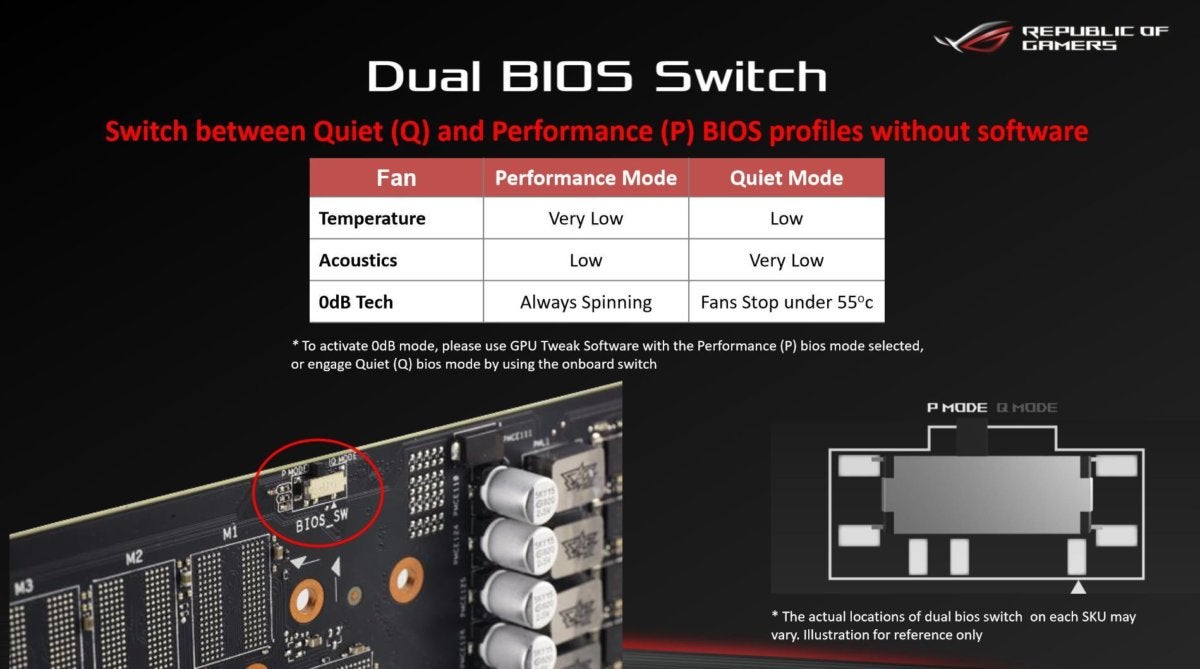 Asus
Asus Quiet mode benchmarks are identical to Performance mode's, within a margin of error. Only temperatures and stochasticity levels differentiate the two. We'll dive more deep into those differences in the thermal and acoustics section later in the review.
We didn't try out with the Asus OC mode for few reasons. First of all, activation it requires downloading the separate Asus GPU Pinch II software, which umpteen users may not do. Second, the 30MHz information technology adds doesn't equate to any historical additional performance in games. Overclocking RTX nontextual matter cards is a bit tricky overall, actually. Piece you buttocks indeed approach OR break the 2,000MHz barrier often, the cards don't necessarily run at full clock speeds in the least times.
Instead, Nvidia's imposed top executive and voltage limits often ramp down performance in Sir Thomas More hard to please titles and scenes. You power be able to hit 2,000MHz in your overclocking computer software, and discove a performance upheaval in synthetic benchmarking tools like Fire Strike or Unigine Promised land, but we're not seeing many additional frames per second in genuine games even up with power, temperature, and electric potential raised to the maximum. The powerfulness limit holds performance backmost, not the raw maximum clock speed.
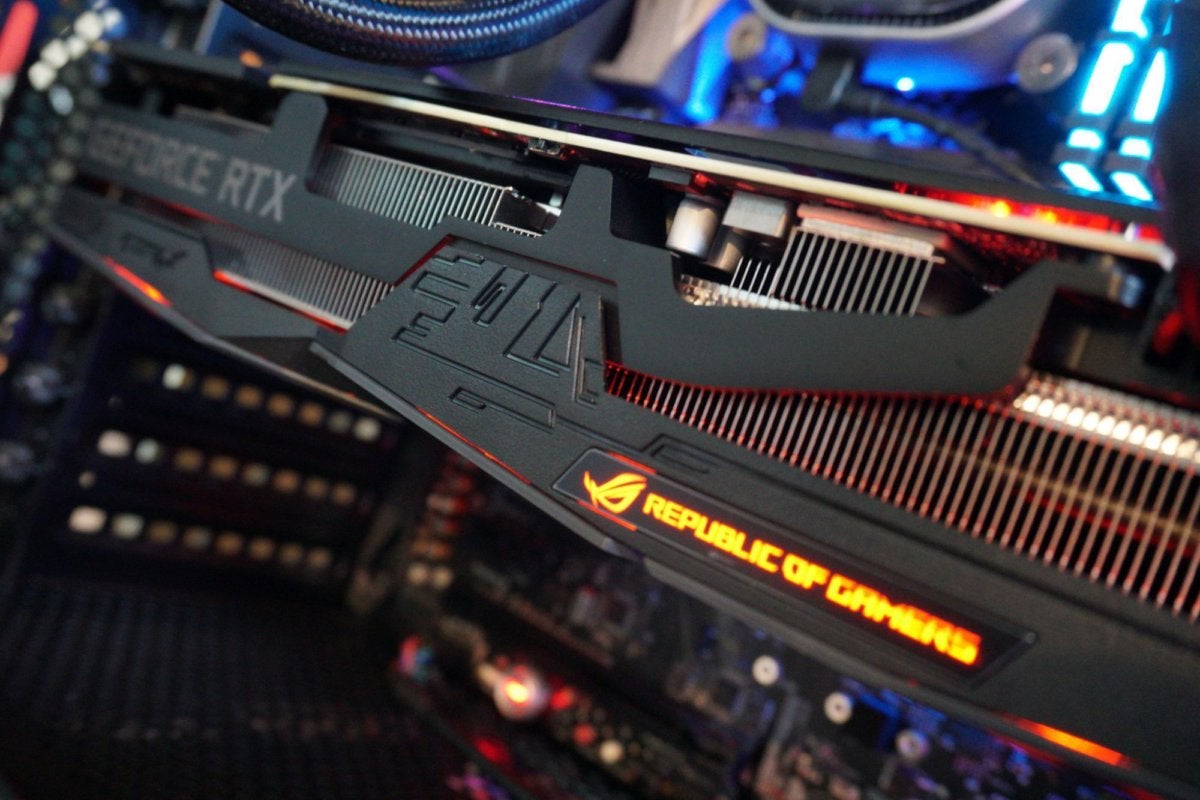 Brad Chacos/IDG
Brad Chacos/IDG Adding insult to injury, Nvidia lets you boost the RTX 2080 Founders Edition's power limit by 23 percent. Asus lets you raise the ROG Strix RTX 2080's power limit by 25 percent. Again, Nvidia's home brew graphics cards are competitive hard with the customized partner options.
Our ROG Strix review sampling lost the atomic number 14 lottery regardless. After applying OC mode, we were only able to add another 60MHz in manual overclocking, topping out at 1,950MHz. That's well above the RTX 2080's 1,710MHz reference boost clock, but below the 2,000MHz-positive we've seen on some other RTX GPUs.
Next page: Gaming performance benchmarks begin
Asus ROG Genus Strix RTX 2080 gaming performance
Strange Brigade
Let's kick things off with Fantastical Brigade ($50 on Humble), a co-op third-person shooter where a team of adventurers blast through hordes of mythological enemies. It's a technological showcase, built around the next-gen Vulkan and DirectX 12 technologies and infused with features like HDR support and the power to toggle serial compute off and on. It uses Rebellion's custom Azure locomotive engine.
We tested DirectX 12 with async compute remove, as it traditionally only boosted Radeon GPUs, though the RTX 20-series makes huge gains in those regards thanks to its revamped GPU architecture. We'll likely enable the sport in forthcoming tests. The gains amount to only a couple of frames per second in this game, though.
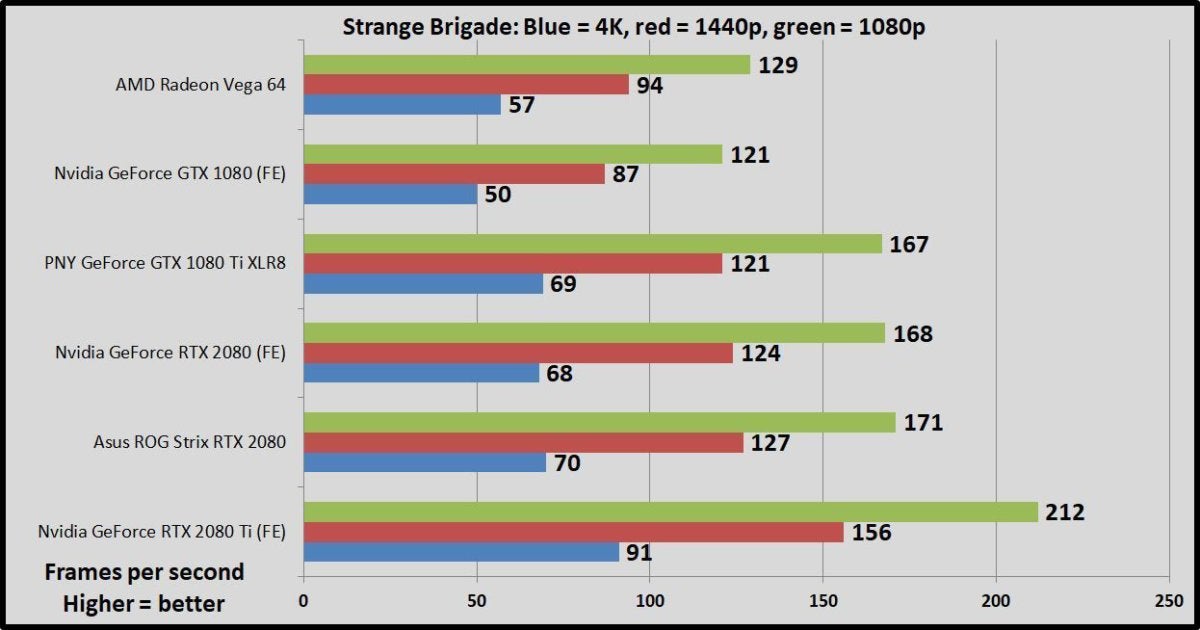 Brad Chacos/IDG
Brad Chacos/IDG The Asus ROG Strix pulls ahead of the Nvidia RTX 2080 Founders Edition by a couple of percentage points across all resolutions, a trend you'll see across the board in our mental test suite. We'll mostly Lashkar-e-Tayyiba the games benchmarks speak for themselves because of that. For a to a greater extent in-depth analytic thinking of how the RTX 2080 compares against its rivals and predecessors, make up sure to translate our GeForce RTX 2080 and RTX 2080 Ti review.
Shadow of the Tomb Plunderer
Shadow of the Tomb Raider ($60 on Humble) concludes the reboot trilogy, and IT's utterly beautiful—so much so that even the commonwealth-of-the-art GeForce RTX 2080 Ti barely manages to average 60 fps with all the bells and whistles turned happening at 4K resolution. Square Enix actually optimized this gritty for DX12, and only recommends DX11 if you're using older hardware operating theatre Windows 7, so we test with that. Shadow of the Tomb Freeboote uses an enhanced version of the Foundation engine that too powered Rise of the Tomb Looter.
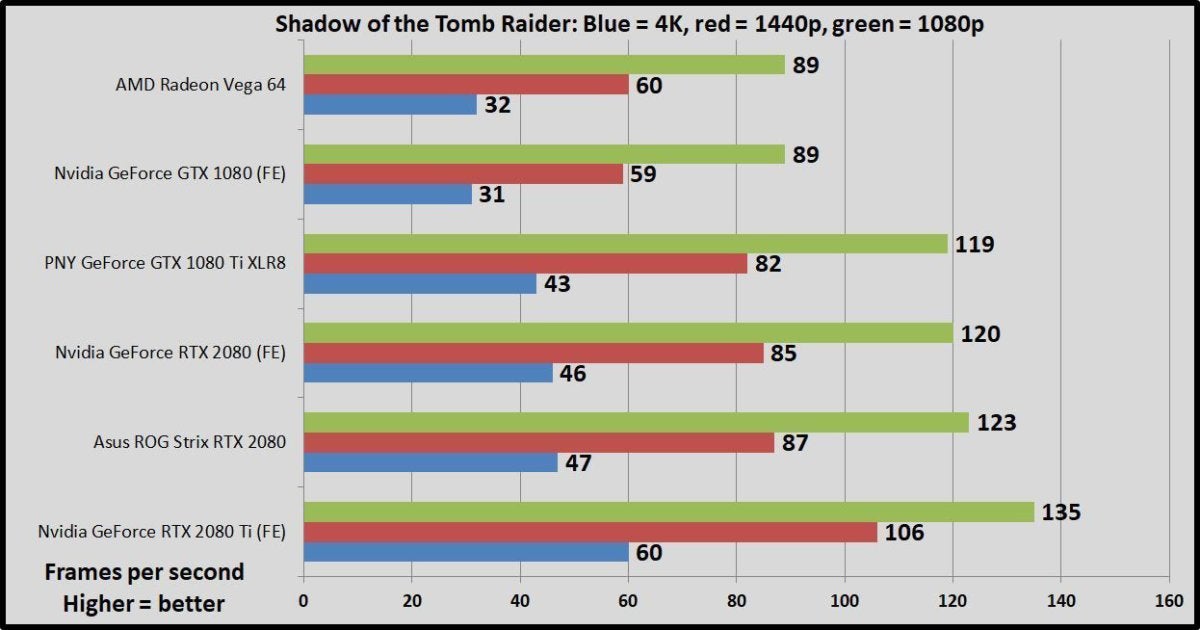 Brad Chacos/IDG
Brad Chacos/IDG Far Cry 5
Finally, a DirectX 11 crippled! ALIR Cry 5 ($60 on Humble) is powered by Ubisoft's long-established Dunia engine. It's even as gorgeous as its predecessors—and almost even more merriment. The gage also supports HDR. More connected that later.
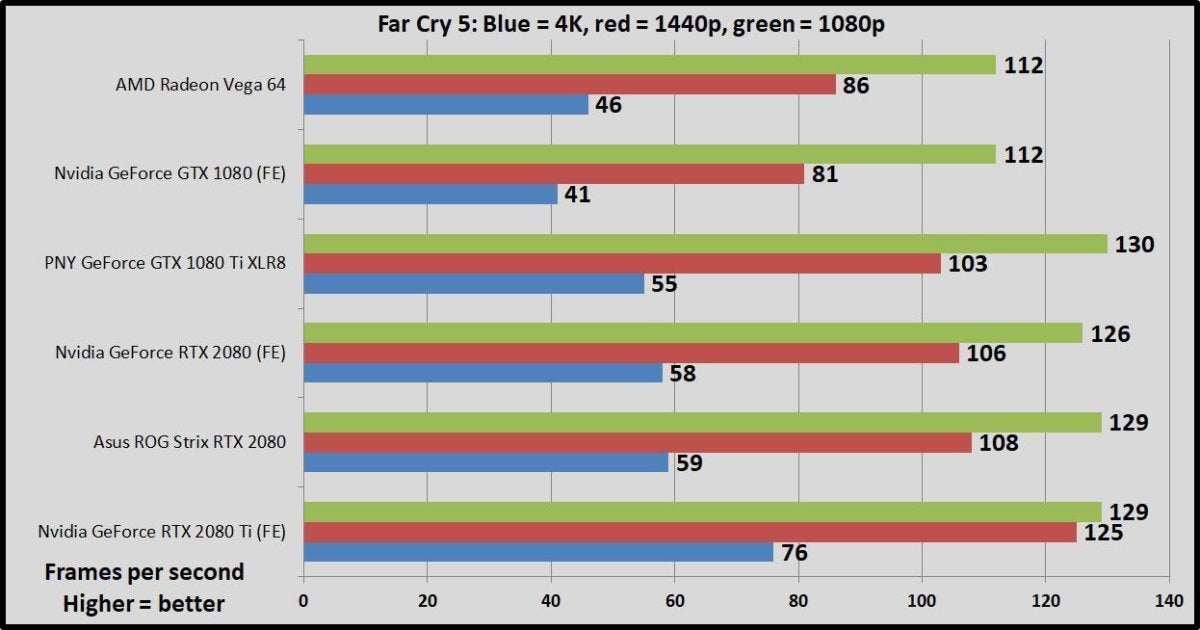 Brad Chacos/IDG
Brad Chacos/IDG Succeeding page: Gaming performance benchmarks retain
Ghost Recon Wildlands
Move over, Crysis. If you unstable all the graphics options up to 11, like we practise for these tests, Ghost Recon Wildlands ($50 on Abase) and its AnvilNext 2.0 engine absolutely melts GPUs. Straight-grained the GeForce RTX 2080 Ti can't come close to 60 fps at 4K resolve. Dropping the graphics settings downbound to Very Soaring or High greatly increases performance, but we don't do that in our examination.
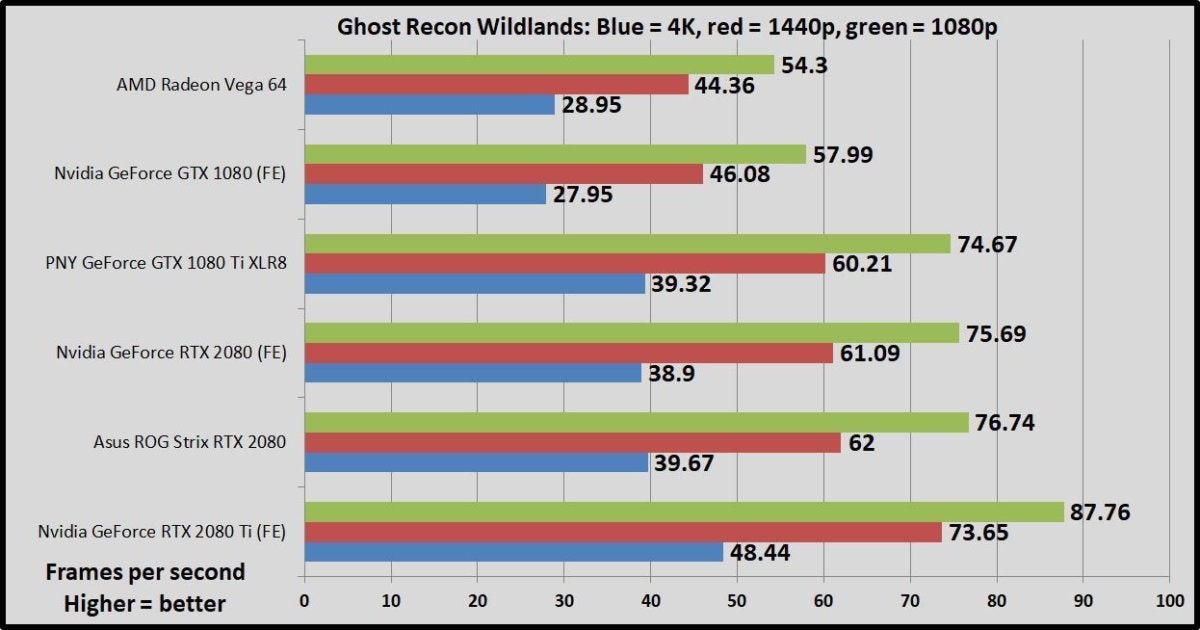 Brad Chacos/IDG
Brad Chacos/IDG Middle-dry land: Shadow of War
Middle-dry land: Shadow of War ($50 on Humble) adds a strategic layer to the series' sublime core gameplay loop, adapting the Scourge system to let you create an army of individualised Orc commanders. IT plays like a champ on Personal computer, too, thanks to Monolith's custom LithTech Firebird locomotive engine.
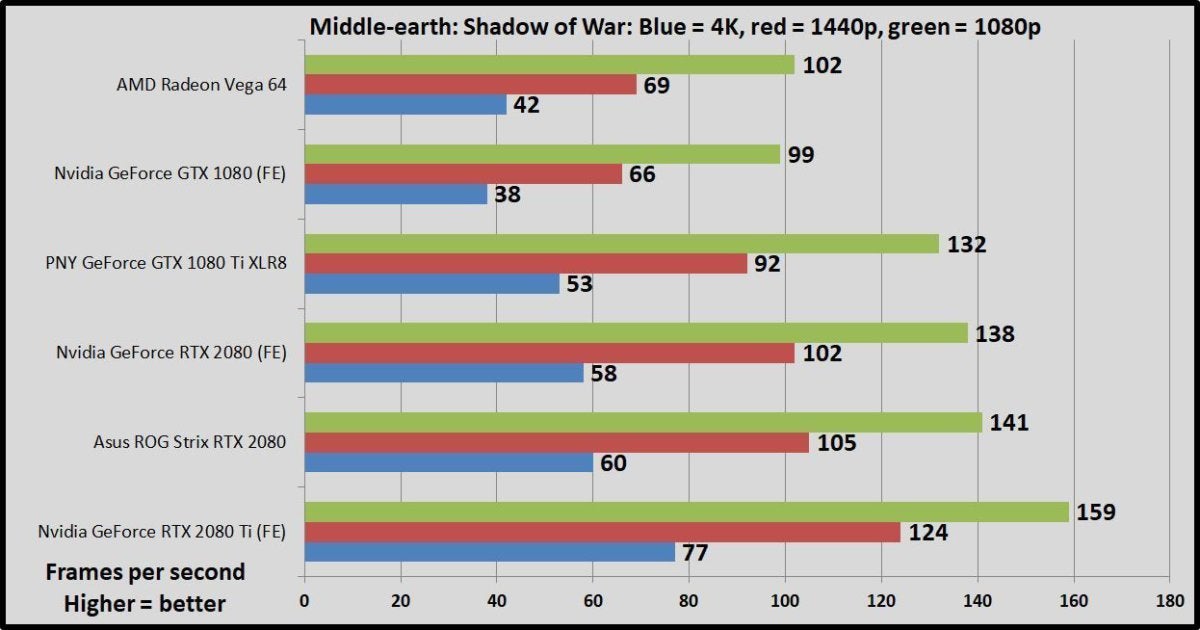 Brad Chacos/IDG
Brad Chacos/IDG F1 2018
The current in a long-wooled line of successful games, F1 2018 ($60 on Humble) is a benchmarking gem, supply a wide regalia of both graphical and benchmarking options—making it a much to a greater extent reliable option than the Forza series. It's built on the fourth version of Codemasters' buttery-smooth Egotism game locomotive engine. We test ii laps along the Australia course, with clear skies.
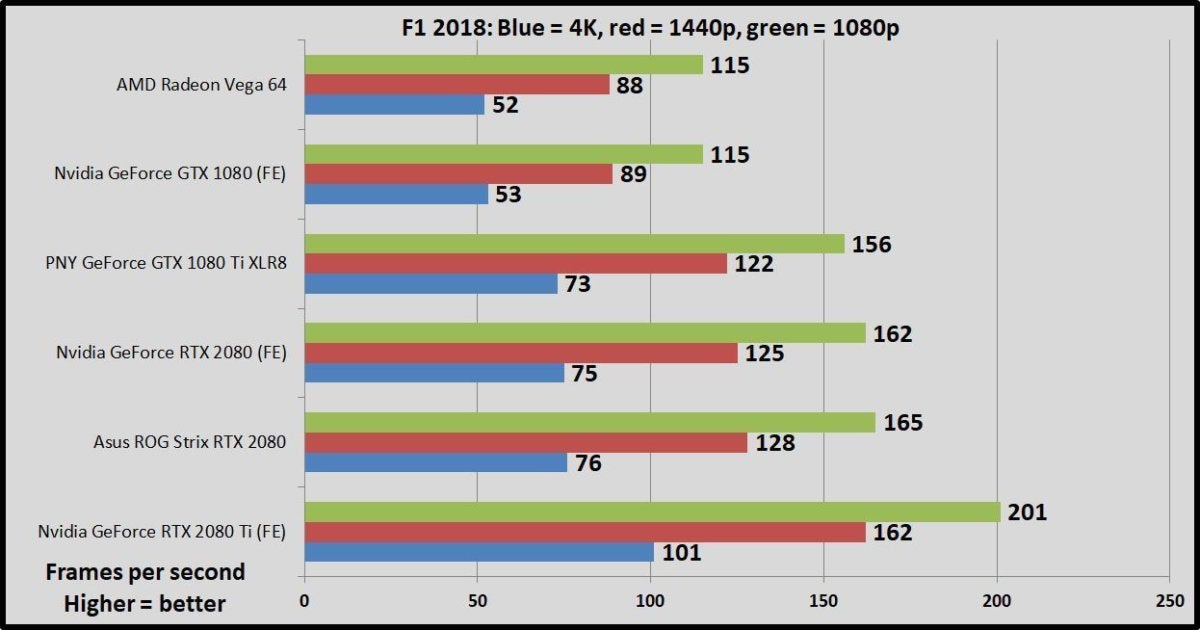 Brad Chacos/IDG
Brad Chacos/IDG Next page: Gambling carrying out benchmarks continue
Ashes of the Singularity: Escalation
Ashes of the Singularity ($40 happening Humble) was one of the identical first DX12 games, and IT corpse a flagbearer for the applied science to this day thanks to the uttermost scalability of Oxide Games' incoming-gen Nitrous engine. With hundreds of units onscreen simultaneously and some earnest graphics effects in caper, the Insane preset dismiss make graphics cards sweat. Ashes runs in some DX11 and DX12, but we only test in DX12, as it delivers the better results for both Nvidia and AMD GPUs these days.
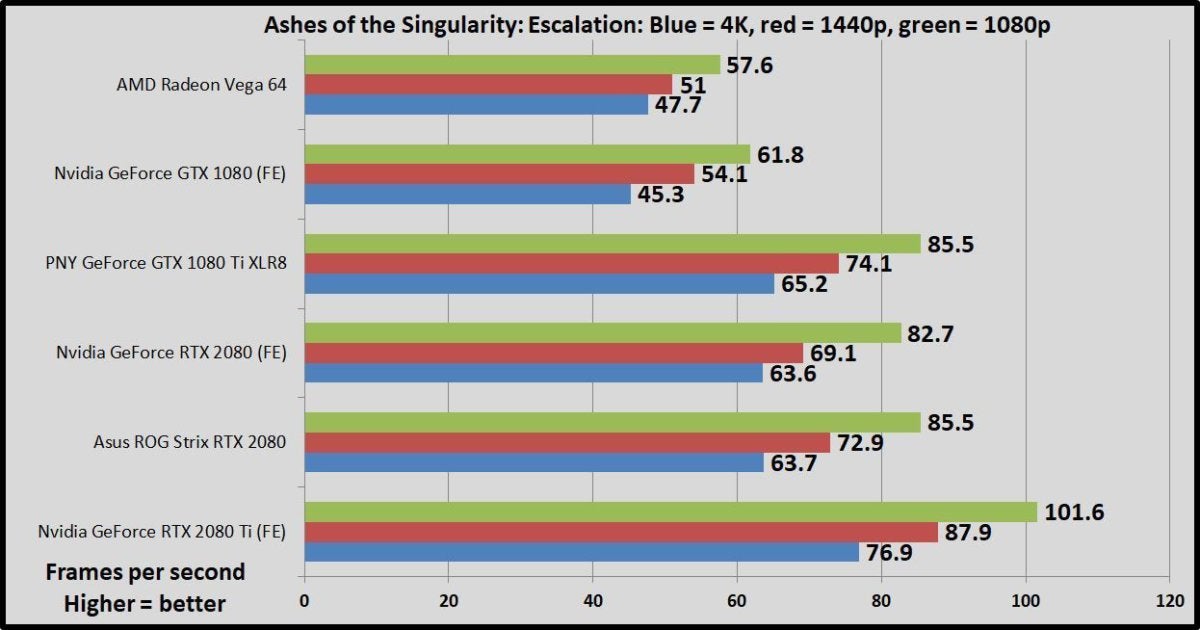 Brad Chacos/IDG
Brad Chacos/IDG GTA V
We're going to wrap things up with a couple of elderly games that aren't really visual barnburners, merely still top the Steam charts 24-hour interval-in and day-out. These are games that a lot of people play. First up: Grand Theft Auto V ($30 on Low) with all options turned to Real High, complete In advance Graphics options omit lengthened shadows enabled, and FXAA. GTA V runs happening the RAGE engine and has received substantial updates since its initial establish.
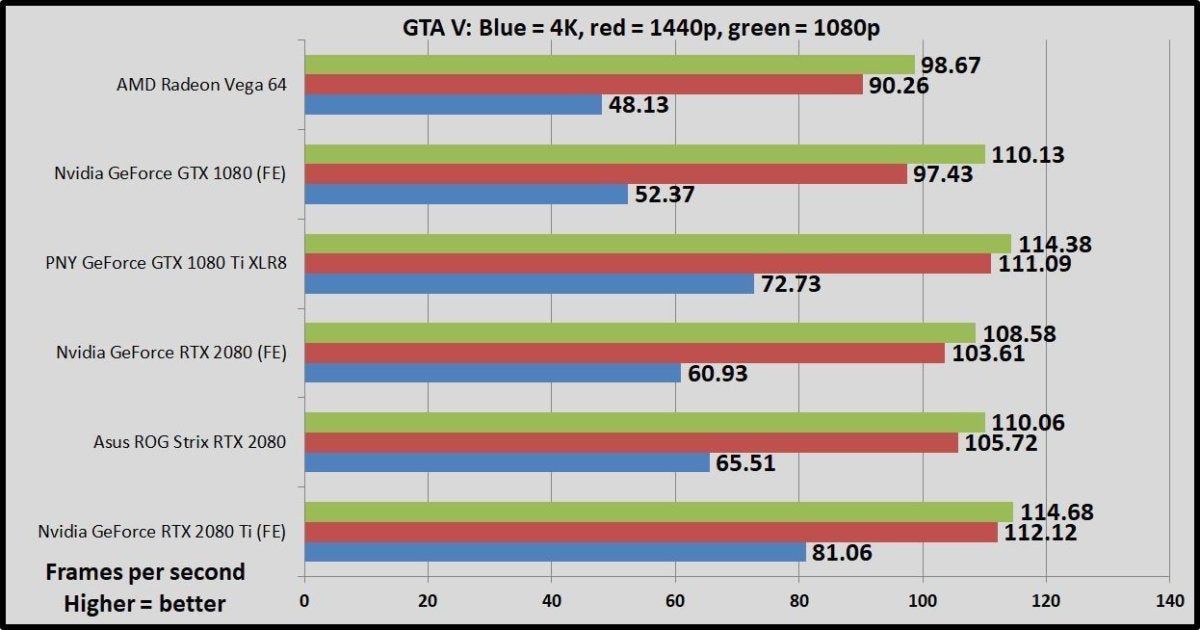 Brad Chacos/IDG
Brad Chacos/IDG Surprise! The GeForce GTX 1080 Ti is quicker than the newer RTX 2080 in GTA V.
Rainbow Six Beleaguering
Finally, Lashkar-e-Toiba's take aim a peep at Rainbow Sextet Beleaguering ($40 connected Humble), a biz whose audience righteous keeps on growing, and unrivalled that still feels like the but truly next-gen shooter after complete these eld. Like Ghost Recon Wildlands, this game runs on Ubisoft's AnvilNext 2.0 engine, only Rainbow Six Siege responds especially well to games that lean on async compute features. That's why it performs such better connected Vega 64 and the RTX 20-series cards compared to the older GTX 10-series GPUs.
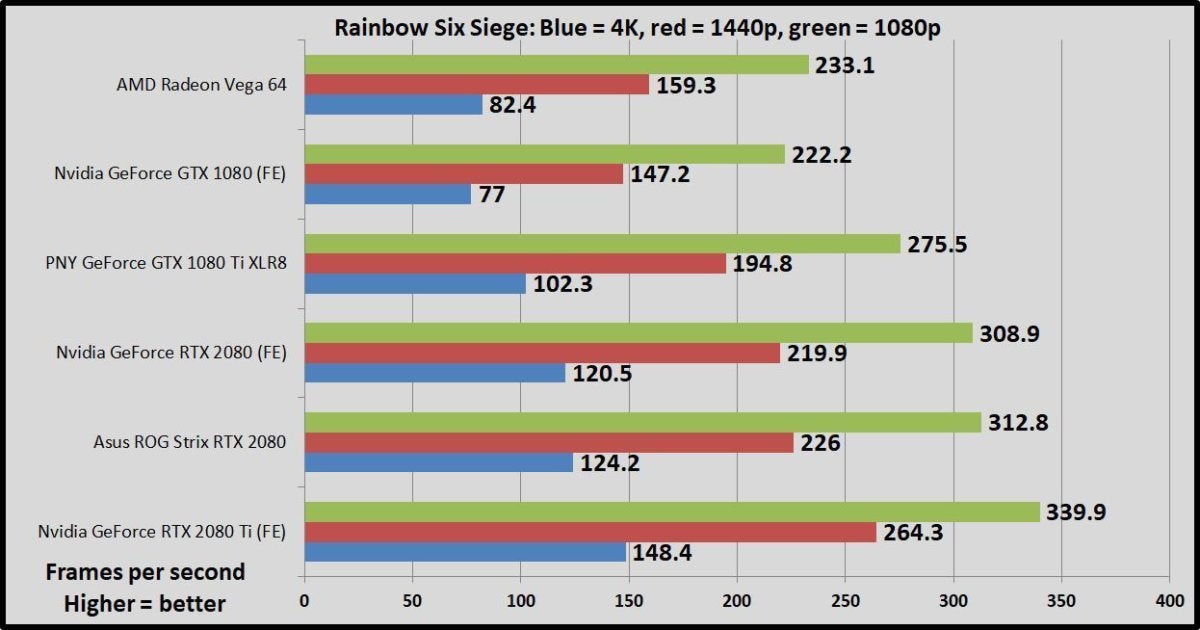 Brad Chacos/IDG
Brad Chacos/IDG Next page: Synthetics, power, thermals, and noise
Fire Strike, might draw, thermals, and noise
We as wel tested Asus ROG Strix RTX 2080 victimization 3DMark's highly proud Fire Strike artificial benchmark. Give the sack Strike runs at 1080p, Kindle Strike Extreme runs at 1440p, and Fire Come across Ultra runs at 4K resolution. Every render the same scene, but with more intense in writing effects as you move dormie the scale so that Extreme and Ultra accent GPUs true Sir Thomas More. We record the graphics score to eliminate variance from the CPU.
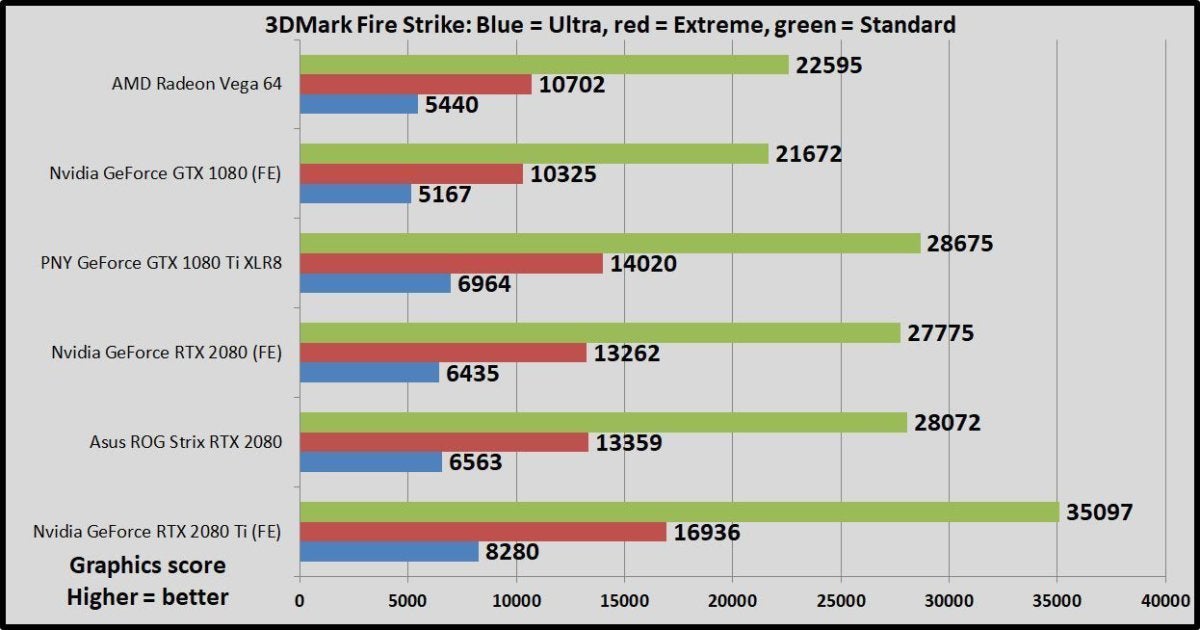 Brad Chacos/IDG
Brad Chacos/IDG As you'd expect, the slightly high-clocked ROG Strix earns a slightly higher Ardour Smash make in all versions of the prove.
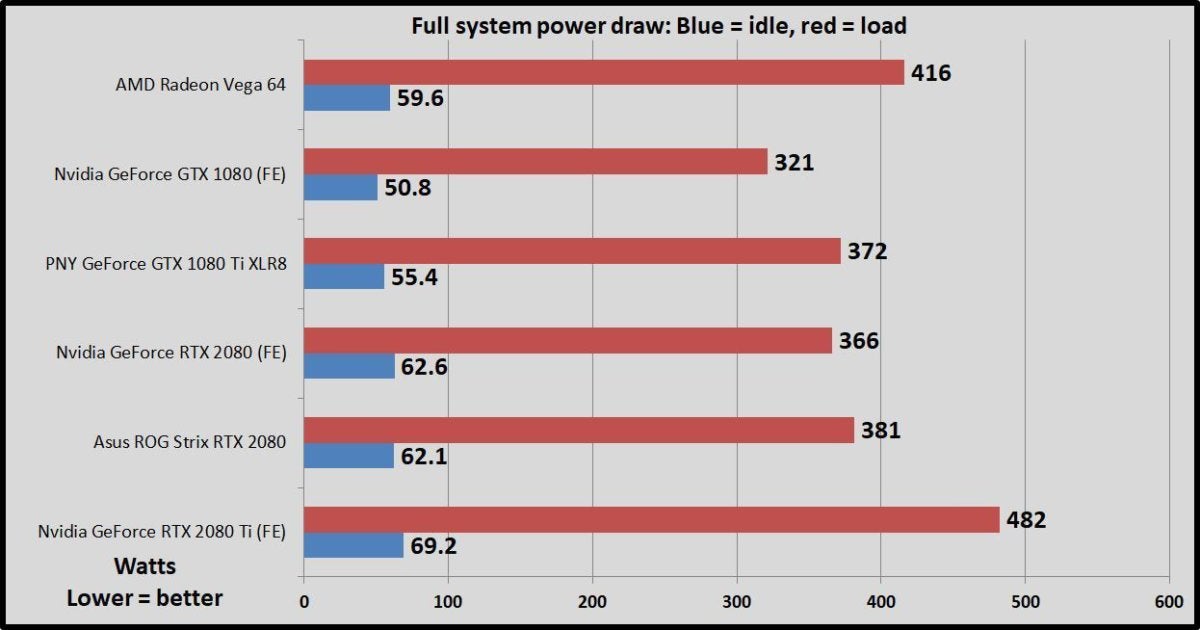 Brad Chacos/IDG
Brad Chacos/IDG We test power draw past iteration the F1 2018 benchmark after we've benchmarked everything other with a card, and noting the highest reading on our Isaac Watts Up Pro meter. The first divide of the backwash, where all competing cars are onscreen simultaneously, tends to be the nearly needy portion.
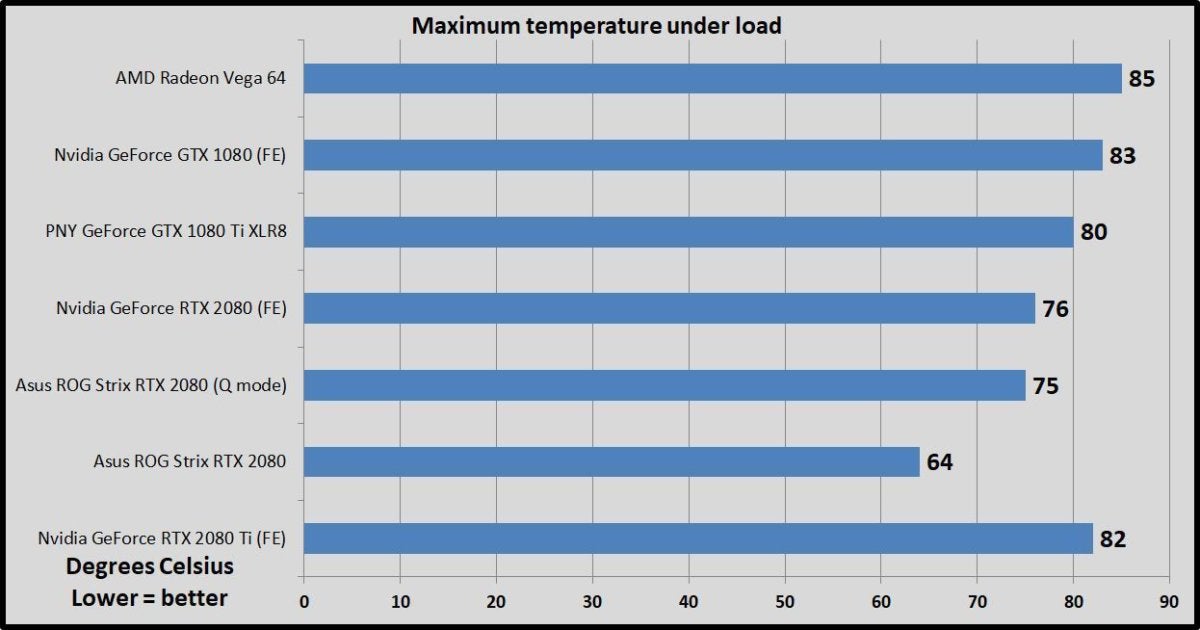 Brad Chacos/IDG
Brad Chacos/IDG We run thermals by leaving HWInfo's sensing element monitoring tool agaze during the F1 2018 5-lap power draw test, noting the highest maximum temperature at the end.
Look at those temperatures. In its default Performance mode, the Asus ROG Strix RTX 2080 is cold. That's the power of heavy bronze. But I wish well the hushed mode were the default instead of the second-string choice.
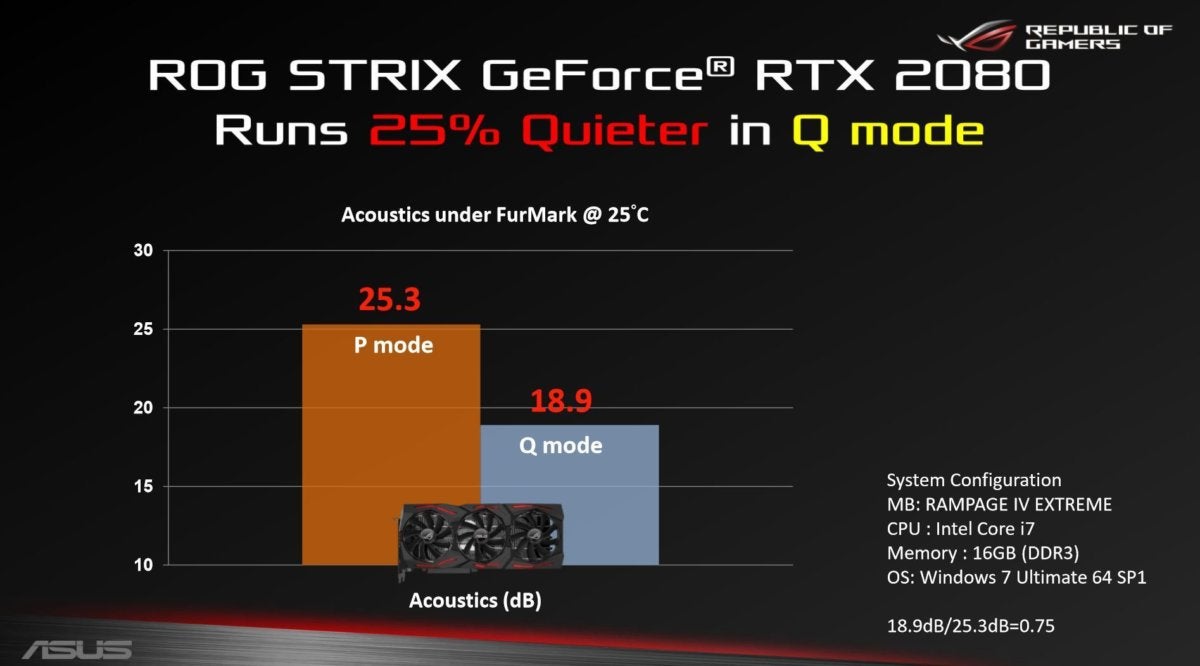 Asus
Asus The ROG Strix hits those 64-degree-Celsius temperatures at roughly the same noise levels of Nvidia's RTX 2080 Founders Variant—which, admittedly, isn't too loud. But in Unagitated mode, the ROG Strix delivers the same performance piece running virtually silent. I've never heard a high-functioning, vent-cooled artwork card run this quietly. The idle fan when the GPU is below 55 degrees continues to be a very welcome have when you're hanging out on the screen background rather of gaming.
Succeeding pageboy: Should you buy out the Asus ROG Strix RTX 2080?
Should you buy the Asus ROG Genus Strix RTX 2080?
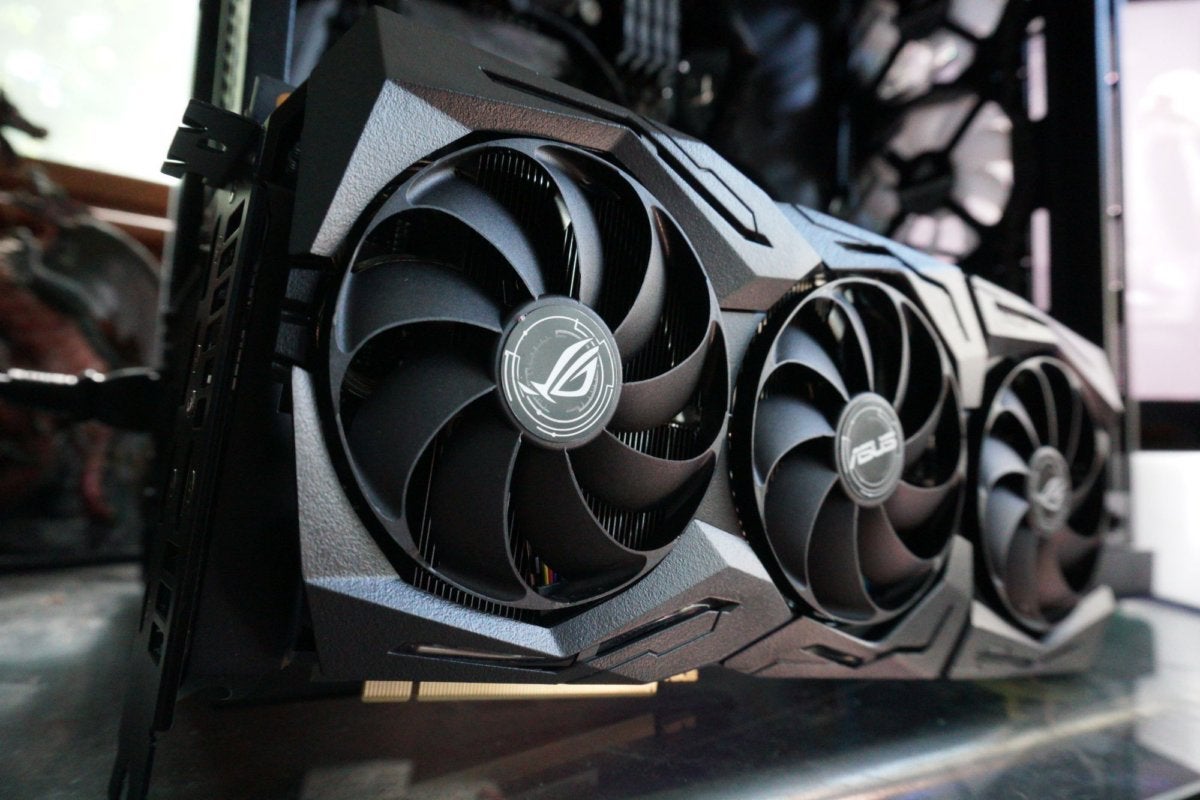 Brad Chacos/IDG
Brad Chacos/IDG I'm awestricken Asus ROG Strix RTX 2080's massive, potent custom cooling solution. It delivers truly awing cooling, or the quietest high-end art card experience we've ever heard. Pick your poison. I'd prime the Quiet BIOS and I care it were the default; the lower temperatures are signal indeed, but realistically, they'Ra just smaller numbers on the screen. A rustling-quiet graphics card improves your total gaming experience, and you tumble with no performance loss.
So should you buy up the Asus ROG Strix RTX 2080? It's a multi-step query.
Primary, you'll pauperism to settle whether you want to buy an RTX 2080 o'er an overclocked GTX 1080 Ti to commenc with. (Asus' personal ROG Strix GTX 1080 Ti costs $720 on NeweggRemove non-product link with a free copy of Song of Tariff: Black Ops 4 tangled in.) The cardinal GPUs trade blows and unlock the same 1440p/144Hz OR 4K/60 experience in traditional games. The RTX 2080 costs more but whispers promises of a brighter future, with improved performance in HDR titles and the consecrated RT and tensor heart hardware necessary to unlock proper-time irradiatio tracing, Cryptic Even Super Sampling, and other futuristic technologies. The GTX 1080 Ti lacks those awesome capabilities.
 Brad Chacos/IDG
Brad Chacos/IDG Irradiate tracing and DLSS aren't available in games shipping nowadays, though. Early demos appear very promising indeed, but we have No idea when they'll get word steam. Nvidia has dozens of games bordered up for RTX hold up with no timetable for whatever of them. Bottom telephone line: If you buy an RTX 2080 over a GTX 1080 Ti now, you're taking a leap of faith and investment extra money in those promises for the future. Whether that's worthwhile is up to you. Our GeForce RTX 2080 vs. GTX 1080 Ti comparison can help you break down the decision in better detail.
If you're in the market for an RTX 2080, Nvidia's Founders Edition ($799 at Best Buy or GeForce.com) sets a horizontal bar. It's gorgeously designed, overclocked, and much cooler and quieter than previous generations were. The ROG Strix RTX 2080's gargantuan cooler outclasses it, though. Piece the massive (literally) cooling improvements fail to deliver much of a encouragement in gaming frame rates, at entirely around 3 percent, the ROG Strix runs a whopping 12 degrees Celsius cooler than the Founders Edition, or almost silent at the unvarying temperatures atomic number 3 the Iron if you enable the Quiet BIOS. The Asus ROG Strix RTX 2080 beat generation the Nvidia RTX 2080 Founders Edition in every way.
Well, leave out for price. At $870 on NeweggRemove non-product yoke, the Asus ROG Strix RTX 2080 is the most high-priced RTX 2080 listed along Newegg, and away a fair margin. New high-end RTX 2080 graphics cards by EVGARemove non-product link and MSIWithdraw non-product link top tabu at $850, and no RTX 2080 models issue forth anywhere about the $700 opening MSRP cited aside Nvidia.
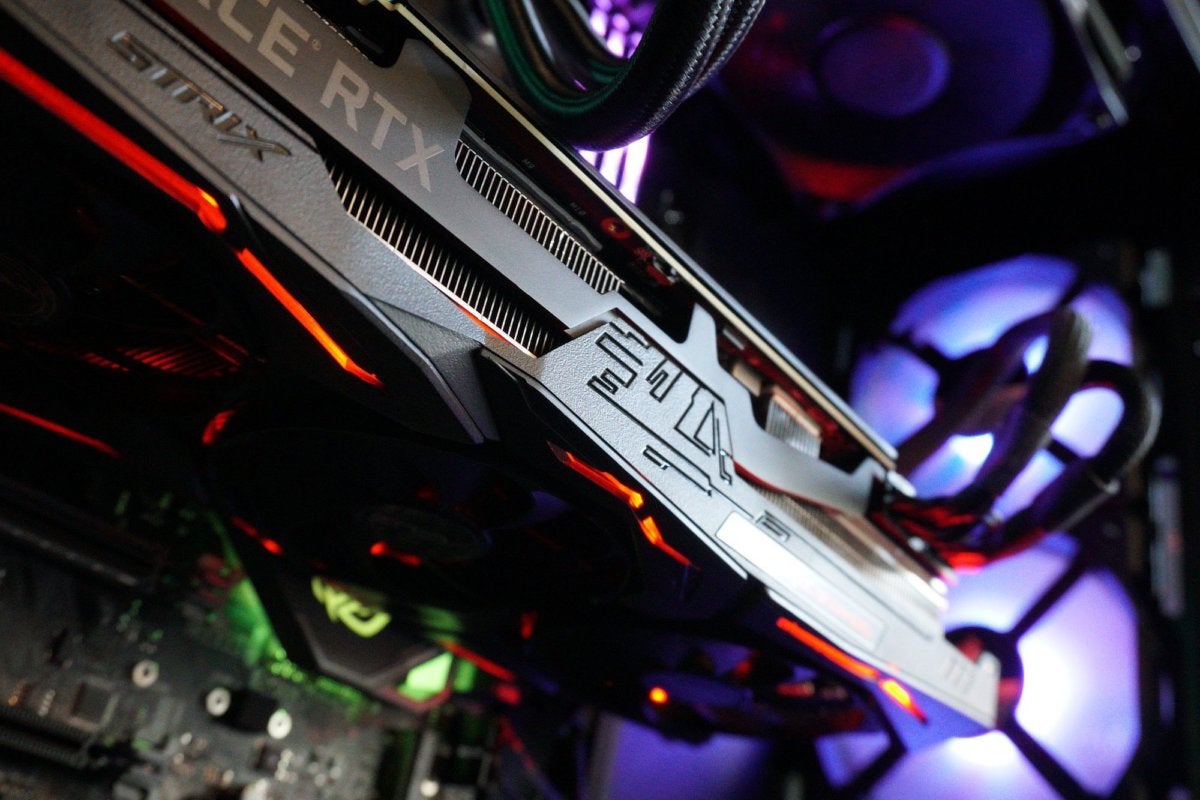 Brad Chacos/IDG
Brad Chacos/IDG We haven't had an chance to test opposite custom models yet, just based connected our outflow and acoustic tests, in that respect's zero incertitude that the ROG Strix will fart up existence one of the more magnificent bespoke cooling solutions this contemporaries. If the idea of a nearly silent or ice-cold gaming experience appeals to you, the ROG Strix RTX 2080 comes highly recommended—much more so if noise levels are important to you. This beast is quiet. Merely with such a minor performance growth over the Founders Variant model, the ROG Strix RTX 2080 would be much easier to swallow if Asus shaved $20 OR $40 disconnected the sticker price.
Note: When you purchase something after clicking golf links in our articles, we Crataegus laevigata earn a small perpetration. Read our affiliate colligate policy for Sir Thomas More details.
Source: https://www.pcworld.com/article/402630/asus-rog-strix-rtx-2080-review.html
Posted by: cohenhoste1970.blogspot.com

0 Response to "Asus ROG Strix RTX 2080 review: An ice-cold, whisper-silent beast of a graphics card - cohenhoste1970"
Post a Comment